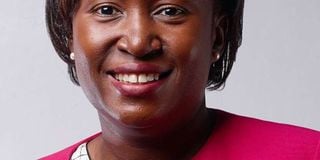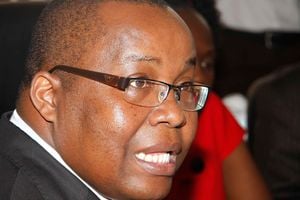Women, power and the newsroom

What you need to know:
- In the 1960s, women in newsrooms made coffee and were mostly secretaries - not editors, anchors or media leaders.
- Gatekeepers of “news” were men, and they decided what the public saw, read and heard about.
- A gender-balanced newsroom is long overdue, in Kenya and around the world.
- In Kenya, the number of women in leadership roles continues to grow- last year, veteran journalist Pamela Sittoni was appointed the Executive Editor of Daily Nation.
When legendary U.S. radio journalist Cokie Roberts died last year, people heralded her as a pioneer who paved the way for women in newsrooms.
In the 1960s, when Roberts started her career at National Public Radio (NPR) in Washington D.C., women made coffee and were mostly secretaries - not editors, anchors or media leaders.
The gatekeepers of “news” were men, and they decided what the public saw, read and heard about.
Ms Roberts challenged that and had to prove herself a doubly smart, capable and talented journalist.
“She was one of the few women on Sunday talk shows when I was growing up,” tweeted Washington Post reporter Heather Long. Roberts inspired her to go into journalism.
WORKFORCE
“When I was in high school, I wanted to grow up to be Cokie Roberts,” said NPR journalist Rachel Martin.
A gender-balanced newsroom is long overdue, in Kenya and around the world.
Of the 522 companies surveyed by the International Women’s Media Foundation (IWMF) in 2018, women represented only a third of the full-time journalism workforce.
In the last decade, we have begun to see change - although pandemic-fuelled hiring freezes and layoffs could slow this down.
In recent years, National Geographic, NPR and USA Today appointed female editors for the first time.
In 2015, The Guardian (U.K.) appointed its first female editor in chief in its 174-year history. Katharine Viner has spearheaded the paper’s first profit in two decades - one of the most significant turnarounds in recent British media history.
EXECUTIVE EDITOR
In 2019, the BBC succeeded in making women half of those seen, read about or listened to across its more than 74 English language outlets and ten World Service language teams.
The New York Times has had only one female executive editor in its 168-year history, and she was fired after two years (in part amidst accusations she was “too bossy”).
However, in 2017, they appointed their first gender editor to increase stories about women and gender across the newsroom. Neither the Wall Street Journal nor The Washington Post has ever had female heads.
Meanwhile in Kenya, the number of women in leadership roles continues to grow- but these changes are also recent.
According to IWMF, men outnumbered women by more than half across the five Kenyan news companies included in the survey.
FEMALE BOSS
Last year, veteran journalist Pamela Sittoni was appointed the Executive Editor of Daily Nation. She’s the first female boss leading a major Kenyan newspaper and oversees a 1,000- strong staff.
Ellen Wanjiru nabbed the top job at KTN, one of Kenya’s biggest television stations, last year while
Queenter Mbori-Saina, an editor at Standard Group, set up the Standard Group Women Network to help empower women in the workplace.
“Women have to work twice as hard to be noticed,” says Ms Sittoni, who has 26 years’ experience in journalism.
“You’ll find newsrooms dominated by senior-level men who don’t even think - or realise - anything is wrong with that. Sometimes I sit in editorial meetings and I’m the only woman with ten-plus men.
“And of course, it affects everything, including the character of the publication you’re putting out. Men know how to compete, and how to network, so if you continue being a nice lady, you will sit there forever and nobody will notice you.”
Women don’t have an equal voice in Kenyan media, explains Nairobi-based journalist Christine Mungai: “Newsrooms are typically run with a masculinist ethos that makes it difficult for a woman’s perspective be seen, let alone valued.”
This sentiment is echoed by Dr. Sharon Adetutu, a coordinator at the Women’s Research and Documentation Centre (Wordoc).
FIXED IDEAS
After analysing content on selected online news platforms, advertisements and blogs across Africa, she found women didn’t often appear in the news. When they did, they were objectified and had little agency.
“Women become images of old, fixed ideas about femininity and masculinity,” she wrote.
“The media environment continues to keep women down.”
Nation newspapers recognised it had a problem. In 2017, in its own pages, public editor Peter Mwaura noted the paper had too few female op-ed writers.
He conducted an informal survey of ‘letters to the editor’ and found that over five days in March 2017, only 12 per cent of the 74 letters published were by women.
“The Nation op-eds, which dominate the national conversation, are essentially an all-male affair,” he wrote.
But, as he notes, women “must be heard” for democracy to thrive.
Nation Media Group has decided to increase reporting on and by women in Kenya. And the result is this new monthly pull out, and more articles, TV and radio segments by and about women across its platforms.
TROUBLEMAKERS
In Kenya, reporting has frequently blamed women for their own deaths, explains Mungai.
Take Sharon Otieno, a 26-year-old student, who was raped and stabbed to death allegedly on the orders of her lover, a county leader. She was seven months pregnant and vilified on radio shows as a “slay queen”, a derogatory term for women who are in transactional relationships with older men.
If women appear in the news, they are often portrayed as troublemakers or being abused and repressed - not as general commentators.
When female voices are marginalised in media coverage, their expertise goes untapped and unheard. As Mwaura pointed out three years ago, readers are in turn being short-changed in knowledge and ideas.
When you bring in a woman’s perspective, there is “real diversity” of thought, experience and outlook, said Mungai.
“This difference in outlook is almost always totally invisible to men.”
For Sittoni, gender diversity needs to be deliberate. It starts with the leaders, who should be made aware that something is missing.
“We can’t just talk about it,” she says, “but we can do a lot.”




